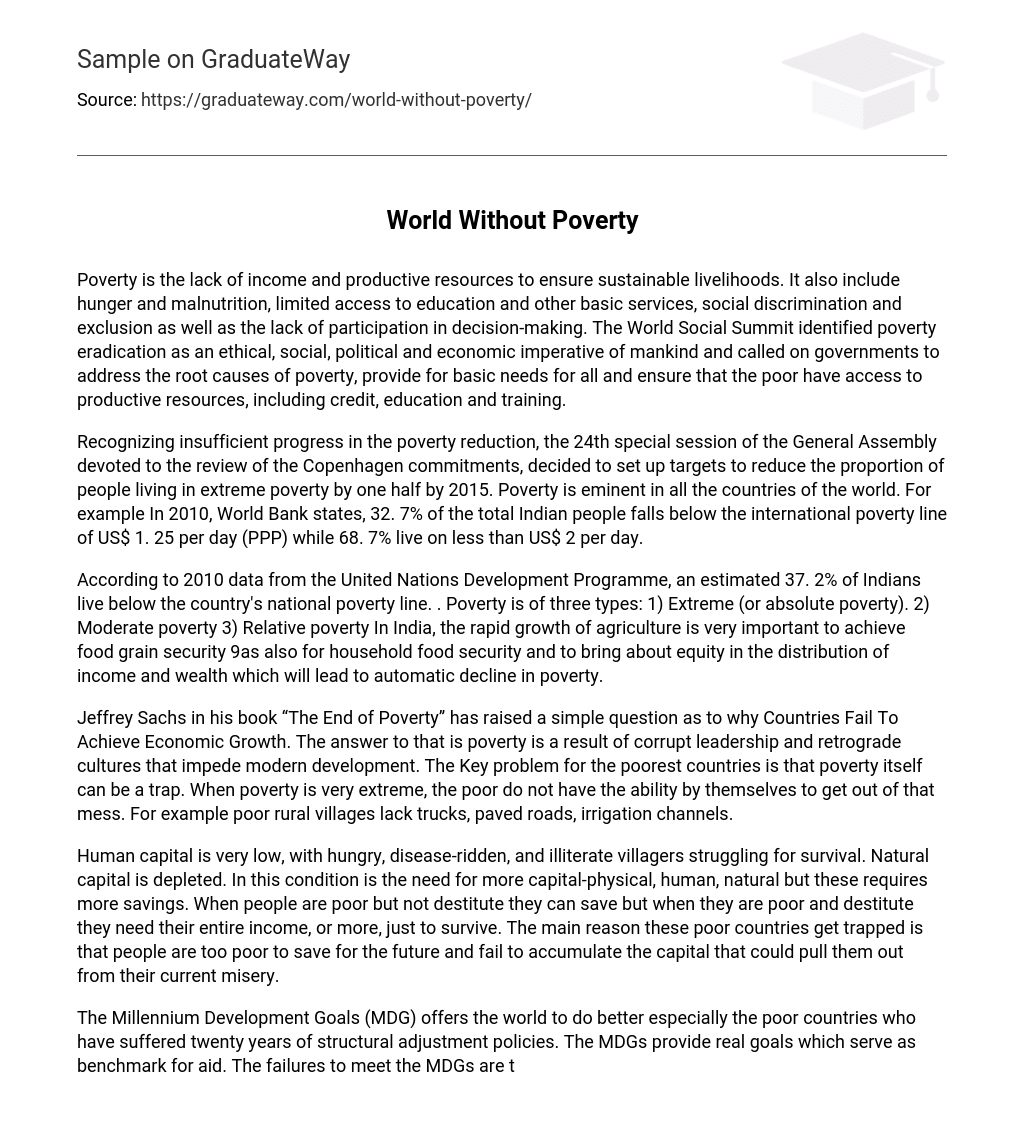Poverty is the lack of income and productive resources to ensure sustainable livelihoods. It also include hunger and malnutrition, limited access to education and other basic services, social discrimination and exclusion as well as the lack of participation in decision-making. The World Social Summit identified poverty eradication as an ethical, social, political and economic imperative of mankind and called on governments to address the root causes of poverty, provide for basic needs for all and ensure that the poor have access to productive resources, including credit, education and training.
Recognizing insufficient progress in the poverty reduction, the 24th special session of the General Assembly devoted to the review of the Copenhagen commitments, decided to set up targets to reduce the proportion of people living in extreme poverty by one half by 2015. Poverty is eminent in all the countries of the world. For example In 2010, World Bank states, 32. 7% of the total Indian people falls below the international poverty line of US$ 1. 25 per day (PPP) while 68. 7% live on less than US$ 2 per day.
According to 2010 data from the United Nations Development Programme, an estimated 37. 2% of Indians live below the country’s national poverty line. . Poverty is of three types: 1) Extreme (or absolute poverty). 2) Moderate poverty 3) Relative poverty In India, the rapid growth of agriculture is very important to achieve food grain security 9as also for household food security and to bring about equity in the distribution of income and wealth which will lead to automatic decline in poverty.
Jeffrey Sachs in his book “The End of Poverty” has raised a simple question as to why Countries Fail To Achieve Economic Growth. The answer to that is poverty is a result of corrupt leadership and retrograde cultures that impede modern development. The Key problem for the poorest countries is that poverty itself can be a trap. When poverty is very extreme, the poor do not have the ability by themselves to get out of that mess. For example poor rural villages lack trucks, paved roads, irrigation channels.
Human capital is very low, with hungry, disease-ridden, and illiterate villagers struggling for survival. Natural capital is depleted. In this condition is the need for more capital-physical, human, natural but these requires more savings. When people are poor but not destitute they can save but when they are poor and destitute they need their entire income, or more, just to survive. The main reason these poor countries get trapped is that people are too poor to save for the future and fail to accumulate the capital that could pull them out from their current misery.
The Millennium Development Goals (MDG) offers the world to do better especially the poor countries who have suffered twenty years of structural adjustment policies. The MDGs provide real goals which serve as benchmark for aid. The failures to meet the MDGs are the fault of both rich and poor countries. During the time of 1980 and 1990 Western Governments enforced draconian budget policies in Africa. The IMF and World Bank ran the economic policies of the debt-ridden continent, recommending regimens of budgetary belt tightening known as structural adjustment programs.
In Africa disease was considered a main reason for poverty and the incapability to have better medical facilities made Africa’s life expectancy at forty-seven in 2000 as opposed to richer countries which have life expectancy of seventy-eight. By the end of 2001 a Global Fund had been established which seek to fight against diseases like Aids, TB, and Malaria. The Global Fund was launched in 2002 to provide billions of additional dollars to combat AIDS, TB and malaria in Africa and the rest of the developing world. Activists claim that lobal pharmaceutical R&D is more concerned with developing lifestyle drugs for western markets than it is for developing drugs for the diseases of poverty. They therefore claim that market driven R&D is contributing to a health crisis in less developed countries. The real problem in these countries is distributing basic, cheap off-patent medicines to those in need. The different projects undertaken to end poverty: 1) The UN Millennium project included Agricultural inputs, Investment in Basic health, Investment in education, Power transport and communication services and safe drinking water and sanitation.
These facilities were to be provided to the poor African countries. As long as the people of the country are malnourished the country can never escape from the poverty trap. 2) The Hunger Project (THP) is a global, non-profit, strategic organization committed to the sustainable end of world hunger. In Africa, South Asia and Latin America, THP seeks to end hunger and poverty by empowering people to lead lives of self-reliance, meet their own basic needs and build better futures for their children.
The Hunger Project believes that by empowering people, families will become healthier and more children go to schools, productivity increases and finally income increases The problem of poverty is rampant in every country even rich countries like United States of America and Great Britain, but poverty is not a major issue in these countries because they have good governance and facilities and provide major aid to the poor in order to elevate the poor from their current position.
The problem at hand is with countries like Africa, India, Zimbabwe and other smaller countries like Democratic Republic of Congo (which is now the poorest country in the world according to survey in 2010) have a major portion of their population below poverty line and the main reasons can be corruption, faulty planning, and population explosion, scarcity of natural resources, increase of illegal immigrants. The Government of these poor countries must provide the basic needs for survival to its poor and give them opportunities to improve their condition.





